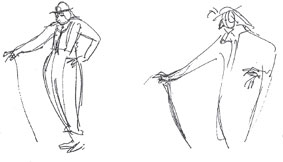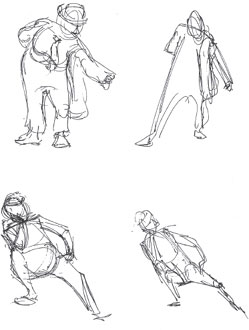143 Feel, as Well as See, the Gesture
While working from a live model, I have found it is better to draw quickly and spontaneously, rather than slowly and overly careful. In the time it takes some artists to do one drawing (and that one often nowhere near completed) others have sketched in three or four tries. This encourages experimentation and looking for alternate interpretations of the gesture. Trying for variations of the pose will sharpen your observation and your hand–eye coordination, and help you to seek out subtle nuances of the gesture. After all, if you had to draw several of the Disney characters in the same pose you’d have to vary each one according to the personality of that character.
In the evening class, I try to get the artists to stop copying the model, especially in a ponderous fashion wherein the gesture is difficult to feel, and so often takes a back seat to the details. I encourage flexibility. Sketching quickly and loosely will help you to be more creative, inventive, and inspired and will train you to be more adaptable and versatile. (It’ll be more fun, too.)
A couple of weeks ago we had the wonderful Bobby Ruth as our model. I think she’s nearly as ancient as I am but she’s just as energetic, and quite a talented actress. She did a clown for us (the night before that she did a sexy nightclub performer). The wonderful play-acting she did unearthed a typical clownlike character that was as distinctive as one of Red Skelton’s characters, or Bob Newhart, or any other performer whose characteristic style is as memorable. If you saw Bobby in a supermarket checkout line, she might blend into the crowd, but while performing, she has that unique ability to carry us beyond the ordinary. She seems to transform herself into another realm — one of pure gesture. Bobby is not the only model who does this. Craig Howell, our carpenter, waiter, and gardener does it too. Our own people do it when we have them pose for us. They bring us marvelous bits of life to sketch (to capture). But it’s not just the job of the model to do this — it’s our goal too — to go beyond just making a drawing of arms and legs and clothes. We want to draw something that tells a story … like our models do.
Drawing is really your reaction to life — to the bits of life you are sketching. It is not merely a collection of parts being put down on paper. It’s more like the colorful display of 4th of July fireworks after they have exploded in the sky, revealing their final “gesture.” You can’t see that gesture by just handling the physical thing called a Sky Fountain, or whatever they are called, it has to explode to reveal its beauty. So it is with a drawing. Handling the human parts of the body will reveal nothing but the means to the end. The end is when it assumes one of its story-packed gestures. As you draw, you feel as much as see the gesture as it comes to life on your paper. There is a kind of flush that grips you. If you are just seeing the parts, they will always remain parts, but if you go for the final “explosive” gesture, the parts will fall into place and the pose magnificent will emerge.
Here’s a paragraph from Drawing on the Artist Within by Betty Edwards, which is quite apropos:
Gesture drawing is a technique of very rapid drawing, one drawing after another, perhaps fifteen scribbled drawings accomplished in fifteen minutes or less. It works, I believe to “set aside” the strong, verbal left-hemisphere mode, perhaps in the following way. L-mode, which prefers a rather slow (relatively speaking) step-by-step linear, sequential, analytic procedure for drawing, preferably using familiar namable forms, says, in effect, “First we’ll draw the head, (let’s see, that’s sort of an oval); then the neck (two lines); then the shoulders (two slanty lines from the neck)….” But in gesture drawing, L-mode finds you drawing helter-skelter, all over the page, saying to yourself, “Just get it down! Faster! Faster!” And L-mode objects, “If you’re going to draw that stupid way, count me out! I like to do things the sensible way — my way! One thing at a time, the way…we… always…do…”And L-mode bows out. Perfect! Just what we want!
Here are some drawings from that session with Bobby Ruth that I felt needed a little help. My “suggestions” were not attempts to make a Rembrandt-like drawing, after all, they were only ten-second sketches of Bobby’s “play-acting.” In her clown costume she was creating a charming clown-like character, and every move she made was typical clown.
For this first pose, I suggested that one of the many possible interpretations might be to let the principles of drawing permeate one’s thinking — squash and stretch, angles, simplification, balance, tension, straight against curve, and perspective. Try to do it in about 10 or 15 seconds. Forget the details — that stuff is all on the “model sheets.”

Here’s one where you might line things up in an attempt to point her attention out to the “audience” she is entertaining. You might drop her right arm to get it out of the look’s way, and curve her back to help send her communication with the audience forward. You might even have the little flower on her hat jump out at then (see the next drawings).

You know the pose — modest, bashful, shy — or better yet pretending to be shy. It’s all in the shoving the hands into the pockets, the dragging of one foot and the tilt of the head, which tries to hide behind one of the shoulders.
And when a clown leans on something, they LEAN. They exaggerate everything to the point of defying gravity.

Here are two more. With the help of all those principles of drawing mentioned earlier, squash and stretch, etc., feel free to “push” these poses just a bit, allowing them to “explode” into what might be termed a caricature of the gesture. You might take it upon yourself in drawing sessions such as this to surpass the model, whoever it might be. After all, they have physical limitations, whereas on paper you have none (see the next drawings).


